





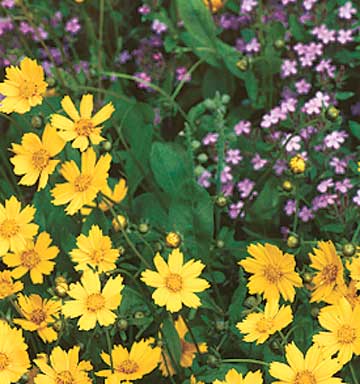 Enjoy spring and summer blooms in the winter with dried flowers.
Enjoy spring and summer blooms in the winter with dried flowers.
It's not necessary to say farewell to all your garden flowers at season's end. There are at least five ways to preserve their beauty to brighten up the dull days of winter.
Many blossoms, such as strawflowers (Helichrysum bracteatum), most daisies, celosia, baby's-breath (Gypsophila elegans), statice (Limonium sinuatum), and the annual ornamental grasses, can be air-dried in a number of ways. Whatever the species, first remove all the leaves, then find a room or area that is reasonably dark but has plenty of ventilation.
Flowers with stiff stems, such as bells-of-Ireland (Moluccella laevis), can simply be placed in a glass jar or vase until they are dry. Those that perch on floppy stems can be hung upside down in loose bundles from individual nails or hooks, or a number of bunches can be attached to wire clothes hangers. Or you can staple a big square of chicken wire to a wooden frame, and suspend the flowers with the stems hanging through the holes.
Often when a vase of flowers is forgotten for weeks, the owner will suddenly find the water has long gone but the flowers have dried naturally. This method works especially well for drying leaves.
Another good method for drying flowers employs the fine white sand that is sold at building and home centers and used for filling children's sandboxes. First find a strong plastic or wooden box that can withstand the weight of the sand, then spread an inch-deep layer of sand on the bottom. Carefully place the flowers on that base and slowly sprinkle dry sand over and about the flowers until they are completely covered. Do not cover the container. Check after three weeks have passed to see if the flowers are dry.
Verbena is a great annual to cut and dry. Click here to learn how to grow it successfully.
continue reading below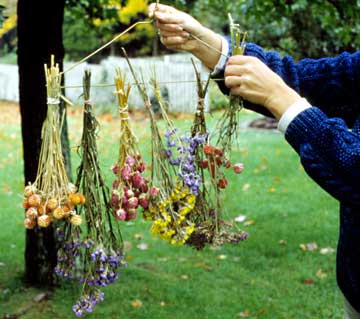 Air-dry annuals in bunches upsidedown.
Air-dry annuals in bunches upsidedown.
Many annuals are beautiful when dried. Among the best flowers for drying are hollyhock blossoms, zinnias, and cosmos dried in sand or silica gel (found at craft and hobby stores); love-lies-bleeding, prince's-feather (Amaranthus hybridus var. erythrostachys), cockscomb, and plumed celosia hung upside down and air-dried; and snapdragons dried in silica gel. Most of the ornamental grasses, including hare's-tail grass (Lagurus ovatus), quaking grass (Briza maxima and B. minor), foxtail millet (Setaria italica), and squirreltail grass (Hordeum jubatum) dry perfectly by hanging bunches upside down in a dry room, but they must be picked when fresh. Don't forget the leaves of dusty-millers, which are elegant when pressed and dried.
Many annuals can be air-dried by gathering them in bunches and hanging them upside down in a well-ventilated place. Hanging them on a coat hanger works well.
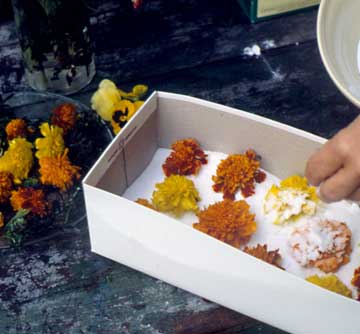 Drying petaled flowers requires adifferent technique.
Drying petaled flowers requires adifferent technique.
1. The classic way to dry flowers is to gather them in small bunches and hang them upside down in a dry, airy place out of direct sun. You might try suspending the flowers from coat hangers.
2. Many-petaled flowers such as zinnias and marigolds often dry best in a desiccant powder like silica gel. Lay the flower heads on a layer of desiccant, then sprinkle more powder over the flowers to cover.
Timesaving Tip: Some annuals will dry perfectly when simply stuck in a bottle. Flowers to dry this way include starflower, statice, globe amaranth, and love-in-a-mist.
Flowers that feel dry and papery are very easy to preserve. The strawflower, for example, has petallike bracts that are firm and brittle. To dry, simply clip the bloom from the plant just beneath the head (the stem doesn't dry well). Select flowers that are just beginning to open. Right after picking, insert a 20-gauge wire through the stem end of the flower head; stick the other end of the wire into a foam board. Let dry for 3 weeks.
Another flower that's easy to air-dry is the globe amaranth. Cut the stems when the flowers are just starting to show color and hang them upside down in a dry area for about 3 weeks. Dry baby's breath, fernleaf yarrow, silver-leaved artemisia, liatris, ammobium, statice, celosia, 'Victoria Blue' salvia, hydrangea, and long-stemmed roses in a similar way. These flowers will dry best if you also follow these tips:
Some flowers, such as dahlias, zinnias, feverfew, delphiniums, snapdragons, and daisies, dry best in silica gel (found at craft and hobby stores). Place flower heads face up on a 1-inch bed of silica gel crystals in an airtight container. Also, gently shake crystals over flowers, covering completely. Seal container. Leave for two days to one week, checking often to avoid overdrying (flowers will become brittle).
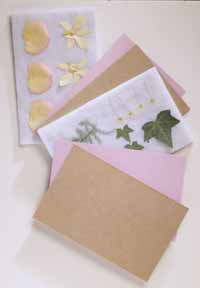
1. Arrange flowers. To press complex or rounded flowers, such as roses, carnations, and mums, begin by dismantling the flower, petal by petal. Arrange the petals on a padded board, making sure that none of the petals touch or overlap.
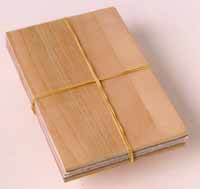
2. Insert into press. Place a sheet of blotting paper over the petals. Then top it with a sheet of cardboard. Repeat this procedure with a second padded board. Stack the two sets of padded boards between the wooden press boards, and bind them together with rubber bands.
3. Allow the flowers to dry for up to several weeks. Or, to speed the process along, place the flower press in a microwave oven and heat for about three minutes on the defrost setting. The heating time will vary with the microwave oven and the thickness of the petals.
4. Microwaving. If you're using a microwave oven, once the flowers are dry, let them cool completely. Then, with a pair of tweezers, gently remove the petals and store them in an envelope or a flat box until you're ready to use them.
Copyright © www.100flowers.win Botanic Garden All Rights Reserved